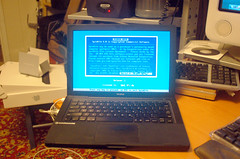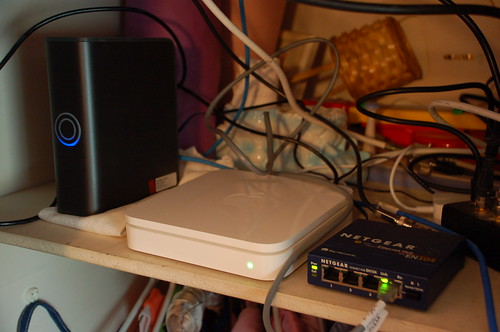Penmachine
28 June 2009
Links of interest 2006-06-21 to 2006-06-27
While I'm on my blog break, more edited versions of my Twitter posts from the past week, newest first:
- My wonderful wife got me a Nikon D90 camera for my 40th birthday this week. I'm thinking of selling my old Nikon D50, still a great camera. Anyone interested? I was thinking around $325. I also have a brand new 18–55 mm lens for sale with it, $150 by itself or $425 together. I have all original boxes, accessories, manuals, software, etc., and I'll throw in a memory card, plus a UV filter for the lens.
- Roger Hawkins's drum track for "When a Man Loves a Woman" (Percy Sledge 1966): tastiest ever? Hardly a fill, no toms, absolutely delicious.
- Thank you thank you thank you to everyone who came to my 40th birthday party—both for your presence and for the presents. Photos from the event, held June 27, three days early for my actual birthday on Tuesday, are now posted (please use tag "penmachinebirthday" if you post some yourself).
- I think Twitter just jumped the shark. In trending topics, Michael Jackson passed Iran, OK, but both passed by Princess Protection Program (new Disney Channel movie)?
- AT&T (and Rogers, presumably) is trying to charge MythBusters' Adam Savage $11,000 USD for some wireless web surfing here in Canada.
- After more than 12 years buying stuf on eBay, here's our first ever item for sale there. Nothing too exciting, but there you go.
- Michael Jackson's death this week made me think of comparisons with Elvis, John Lennon, and Kurt Cobain. Lennon and Cobain still seemed to have some artistic vitality ahead of them. Feel a need for Michael Jackson coverage? Jian Ghomeshi (MP3 file) on CBC in Canada is the only commentator who isn't blathering mindlessly. But as a cancer patient myself, having Farrah Fawcett and Dr. Jerri Nielsen (of South Pole fame) die of it the same day is a bit hard to take.
- Seattle's KCTS 9 (PBS affiliate) showed "The Music Instinct" with Daniel Levitin and Bobby McFerrin. If you like music or are a musician, it's worth watching, even if it's a bit scattershot, packing too much into two hours.
- New rule: when a Republican attacks gay marriage, lets assume he's cheating on his wife (via Jak King).
- The blogs and podcasts I'm affiliated with are now sold on Amazon for its Kindle e-reader device, for $2 USD a month. I know, that's weird, because they're normally free, and are even accessible for free using the Kindle's built-in web browser, so I don't know why people would pay for them—but if you want to, here you go: Penmachine, Inside Home Recording, and Lip Gloss and Laptops. Okay, we're waiting for the money to roll in...
- Great speech by David Schlesinger from Reuters to the International Olympic Committee on not restricting new media at the Olympics (via Jeff Jarvis).
- TV ad: "Restaurant-inspired meals for cats." Um, have they seen what cats bring in from the outdoors?
- I planned to record my last segment for Inside Home Recording #72, but neighbour was power washing right outside the window (in the rain!). Argh.
- You can't trust your eyes: the blue and green are actually the SAME COLOUR.
- Can you use the new SD card slot in current MacBook laptops for Time Machine backups? (You can definitely use it to boot the computer.) Maybe, but not really. SDHC cards max out at 32GB (around $100 USD); the upcoming SDXC will handle more, but none exist in Macs or in the real world yet. Unless you put very little on the MacBook's internal drive, or use System Preferences to exclude all but the most essential stuff from backups, then no, SD cards are not viable for Time Machine.
- Some stats from Sebastian Albrecht's insane thirteen-times-up-the-Grouse Grind climb in one day this week. He burned 14,000+ calories.
- Even though I use RSS extensively, I find myself manually visiting the same 5 blogs (Daring Fireball, Kottke, Darren Barefoot, PZ Myers, and J-Walk) every morning, with most interesting news covered.
- I never get tired of NASA's rocket-cam launch videos.
- Pat Buchanan hosts conference advocating English-only initiatives in the USA. But the sign over the stage is misspelled.
- Who knew the Rolling Stones made an (awesome) jingle for Rice Krispies in the mid-1960s?
- Always scary stuff behind a sentence like, "'He is an expert in every field,' said a church spokeswoman."
- Kodachrome slide film is dead, but Fujichrome Velvia killed it a long time ago. This is just the official last rites.
- My friends Dave K. and Dr. Debbie B. did the Vancouver-to-Seattle bicycle Ride to Conquer Cancer (more than 270 km in two days) last weekend. Congrats and good job!
- My daughter (11) asks on her blog: "if Dad is so internet famous, I mean, Penmachine is popular, then, maybe I am too..."
- Evolution of a photographer (via Scott Bourne).
Labels: amazon, apple, backup, birthday, cancer, film, geekery, linksofinterest, music, news, olympics, photography, politics, religion, science, space, television, twitter
02 June 2008
The hard drive grumblies
A few weeks ago, I replaced the old wireless router in our upstairs den with a new Apple AirPort Extreme base station, which has generally worked great. One extra benefit of the design is that, like Apple's similar Time Capsule, I can use it as a wireless backup device device by hooking up an external USB hard disk, like this:
The disk I use is a 500 GB Western Digital MyBook, perched to the left of the base station itself. If you look closely at the photo, you'll notice that the disk enclosure is sitting on a folded cloth napkin.
Here's why. The shelf all that networking gear sits on is made of light wood, and sits loosely on a wooden lip around the edges of the inside of the den closet. The other side of the closet's back wall is the south wall of our bedroom.
So, after I set up automatic backups for our various Macs using Time Machine and other tools (apparently not officially supported in this setup, by the way!), whenever the hard drive was active (especially at night), our bedroom wall would rumble disconcertingly as the disk mechanism chugged away. The shelf and the closet drywall were acting as a big soundbox amplifier.
And so, the napkin, my half-baked attempt to damp down the vibrations from the disk mechanism. It sort of works. Now, when the drive is active, the wall makes something more akin to subtle stomach-growling noises, rather than louder rumbling. During the day, that's fine, but at night it's still prone to keeping us awake.
The temporary solution has been to make sure backups occur during the day when it doesn't bother anyone. But I still must unhook the USB drive at night to avoid the grumblies, during what seem to be random administrative disk accesses (perhaps search indexing) that occur anyway from time to time. But I'd rather not do that. I'm considering putting some foam under the edges of the shelf itself, or maybe moving the whole setup to different, less resonant part of the closet.
Wow, this sure is a first world problem.
Labels: apple, backup, geekery
30 January 2008
Links of interest (2008-01-30):
A bunch of stuff I've been accumulating over the past few months:
- Types of coffee beverages
- U.S. regional pizza styles
- Build your own Apple Store
- Google Maps mashup of how Greater Vancouver would be flooded by a 4-metre sea level rise (move around to check out your own area nearly anywhere in the world)
- J Allard's thoughts on the first year of the Zune
- Very useful Cascading Style Sheets (CSS) reference for web developers
- How well does restoring from Apple's new Time Machine backup work?
- Intro to Fully Flared features slo-mo skateboarding, explosions
- When you post to your blog, where does the information go?
- Tips to give presentations more like Steve Jobs
- What other sites are on your shared web server?
- How Microsoft would reveal it hasn't done its homework in school (see?)
- New Apple instructional videos
- Long Radiohead video that features all the songs on In Rainbows
Labels: apple, backup, band, blog, environment, extremesports, food, google, linksofinterest, macosx, microsoft, music, publicspeaking, web
29 December 2007
WordPress Automatic Upgrade is great, but you need web-fu if it goes wrong
 This site runs on Blogger, as it has for more than seven years, but if I were starting over again today I'd probably use WordPress. That's what I recommend to my friends and relatives, so that other sites I work with, such as Simon's, my wife's podcast (as well as her personal blog), and Inside Home Recording all use it.
This site runs on Blogger, as it has for more than seven years, but if I were starting over again today I'd probably use WordPress. That's what I recommend to my friends and relatives, so that other sites I work with, such as Simon's, my wife's podcast (as well as her personal blog), and Inside Home Recording all use it.
If you use the free WordPress.com hosting service, all maintenance and upgrades are handled for you by the fine folks who run it. But if, like me, you're reasonably geeky and need the extra customization available by running WordPress on your own server, the main hassle has been that, when a new version of WordPress comes out, upgrading the software involves:
- Backing up your installation.
- Downloading the latest version of WordPress.
- Deactivating all the WordPress plugins on your sever.
- Putting your website into Maintenance Mode (basically, activating a page that says, "Hold on, we'll be right back" to your web visitors).
- Uploading a whole ton of updated files to your server, usually in several stages so you don't accidentally overwrite any of your own customizations, plugins, or themes.
- Running an upgrade script to update the database.
- Taking the site out of Maintenance Mode.
- Checking to make sure nothing's broken.
I've gotten reasonably good at that, but it's still time consuming, especially for multiple sites. Today, while surfing around feeling gross from chemo side effects, I read about the Automatic Upgrade Plugin (via Scott Beale on Twitter). It does all of that stuff with only a few clicks.
I tried it on two websites without a hitch, even using the Automated Mode that avoids the multi-screen, "Here's the next step, CLICK HERE if you're sure you want to proceed" process—with hardly a hitch.
Then, confident, I proceeded to the third site, Inside Home Recording, again in Automated Mode, got almost all the way through, and encountered the dreaded "500 Internal Server Error" page. I tried rolling back to my previous installation of WordPress manually. No dice. I noticed even the IHR forums (which use different software) were dead, which was mysterious and a bit freaky. And when I tried putting a generic "Sorry I broke the site" HTML page at index.php or index.html at the root of the site, it still didn't work. Yikes! I'd blown up the whole website!
I had a hunch, and took a peek at the invisible .htaccess file. That's a plain old text file sitting on the IHR web server (which I think is in Texas). The ubiquitous Apache web server software it's running uses .htaccess as a list to answer the question, "What do I do with stuff on this machine when I sent it out to the Web?" It seems that either WordPress or the Automatic Upgrade plugin had added some extraneous stuff to the end of that file. I deleted the extra text and, bingo, IHR was back up.
Having rolled back to the older version of WordPress, I made sure I had proper backups again (I remind you, back up, back up, back up your stuff), then tried the Automatic Upgrade plugin once more, but this time in Manual Mode (i.e. confirmed each step). No problems on this second attempt, and IHR is spiffed up with the latest software release.
Elapsed time from upgrade to blow up to fix up? Less than ten minutes. Sometimes I'm glad I have some web-fu when I need it.
Labels: backup, blog, family, friends, geekery, insidehomerecording, lipglossandlaptops, podcast, software, web
21 June 2007
Backups mean not having to say you're sorry
 It turns out that my dead hard disk is still well under its five-year warranty, and that Seagate, the manufacturer, has an efficient online return system that helped me diagnose and then set up a return merchandise authorization (RMA) for it, including printing a shipping label for me.
It turns out that my dead hard disk is still well under its five-year warranty, and that Seagate, the manufacturer, has an efficient online return system that helped me diagnose and then set up a return merchandise authorization (RMA) for it, including printing a shipping label for me.
So rather than go through the rigamarole of trying to rescue any data from the drive (as far as I can tell, it's not even spinning up), I mailed it off to Ontario a couple of days ago, and Seagate will send me a new replacement that I can drop in its place. In the meantime I'm using the stock MacBook hard disk, and it's working fine.
Because of my backup regimen, I lost so little data that all I've had to do is go through a few pages of my Flickr photos and re-import the missing ones into iPhoto—nothing else critical is missing. At least not that I've discovered so far.
So I should have a new drive to put into the MacBook next week, and I can use the one I have now once again as an external backup. One thing I do need to do is take some of my recent backups offsite, because right now I'm protected against failures, but if we get burglarized or the house burns down, important data could still be at risk.
You should do the same with your backups. You do have backups, don't you?
Labels: apple, backup, geekery, macbook, repairs, seagate
17 June 2007
The curse of the MacBook
 I thought that a few months ago, when my MacBook laptop finally returned from getting a new heat sink, fan, and battery, it would be stable. But no. Today I was working away, just having uploaded a bunch of photos to Flickr, when the MacBook froze up, which is unusual. I rebooted it.
I thought that a few months ago, when my MacBook laptop finally returned from getting a new heat sink, fan, and battery, it would be stable. But no. Today I was working away, just having uploaded a bunch of photos to Flickr, when the MacBook froze up, which is unusual. I rebooted it.
Click click, said the hard disk. No booting. Grey screen, as if there were no disk inside at all. Not good. This disk is completely invisible to the utilities I own, as if it wasn't even there. I have backups, and very little data on the drive doesn't exist somewhere else, so that's not my worry—I learned my backup lessons years ago.
But it is certainly annoying. The 100 GB, 7200 rpm SATA disk drive is just over a year old: I installed it when I bought the MacBook, putting the stock drive in an external USB housing. It should have lasted much longer than this, but I suspect that all the nasty sudden power shutdowns with the battery problems I had may have damaged it, so that it decided to die today.
I'm typing on the MacBook now, having restarted from my external FireWire backup drive. I've reinstalled the original stock 80 GB, 5400 rpm hard drive and am copying over my data files so that it will work again. It should be in relatively normal shape later tonight.
But I'm not giving up on the bigger, faster drive yet. I don't trust it, but I want to see if I can bring it back to life again. The excellent DOS-based utility SpinRite apparently performs miracles on dead drives like that quite regularly. My dad owns a copy, but it's not intended to run on Macs, and sure enough, when I tried booting his CD on the Intel-based MacBook, it started up fine, but did not recognize the keyboard, so I couldn't do anything.
I'm going to see if I can get a SATA-to-IDE adapter to hook up the disk to one of my dad's Windows PCs, which will run SpinRite and may be able to get the disk working again.
Regardless, I will probably have to get another new internal drive (maybe a bigger one now, 160 GB or 200 GB) as the main one for this machine in the long run. I like this laptop and it has done great work for me, but it's sickly, to be honest.
Labels: apple, backup, geekery, macbook, repairs, spinrite
